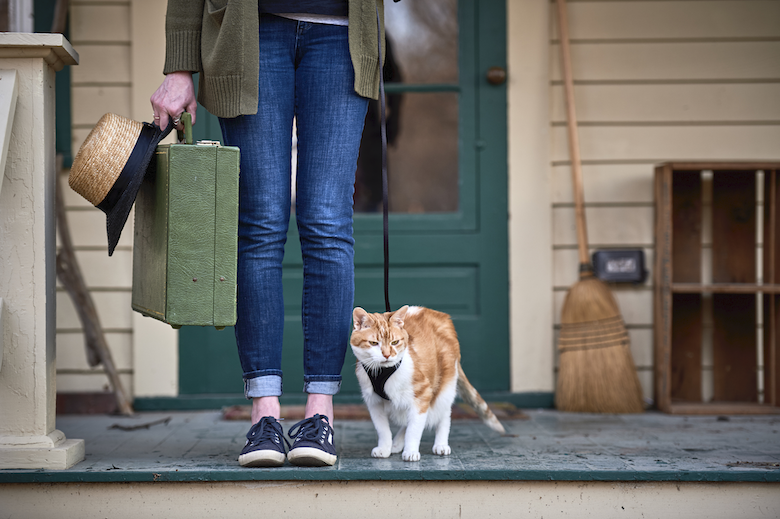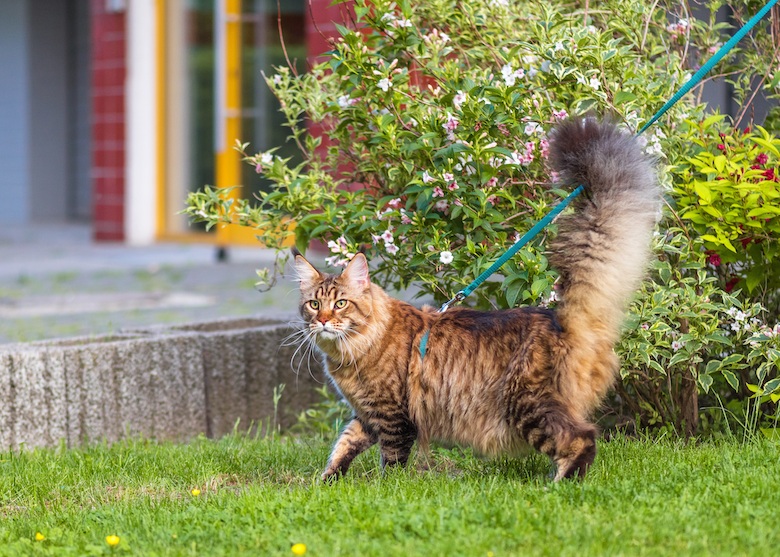Have you ever thought about taking your cat on a walk? Walking leashed cats has become an increasingly popular way to add enrichment to your cat’s life, and it’s something that many cats enjoy. That said, leash walking can also be stressful or even dangerous if not approached carefully. Not all cats are going to enjoy leash walking, so go slowly with introducing the activity to your cat.
Here’s what you need to walk your cat on a leash
For walking your cat, you want to make sure they are wearing a properly fitted harness. Do not walk your cat on a leash attached to their collar. For your cat’s safety make sure that the harness is specifically made for cats and does not have a breakaway feature. Be sure that the harness fits your cat comfortably but snuggly to prevent your cat from backing out of it. You’ll also want a short 4- or 6-foot lightweight leash. This will allow your cat to explore the world while staying close to you. You’ll also want to have high-value treats to reward your cat with.

Photo: thegoodphoto/Getty Images
Leash training tips
Step 1 Taking your cat out on leash requires advanced planning and training. Start first with getting your cat familiar and comfortable with the harness and then the harness and leash. Start at home. Show the harness to your cat and give them treats. We want to help our cats to develop a positive association with the harness and the best way to do that is to pair it with rewards.
Step 2 If your cat is comfortable seeing the harness, try putting the harness on your cat and continue to offer treats. When your cat is wearing the harness, toss treats or bring out a toy for your cat to play. This will both continue to build positive associations to the harness and also allow your cat to become comfortable moving and playing while wearing the harness.
Step 3 While still in the house, attach the leash to your cat’s harness and lure your cat in the direction you want to go with treats; don’t drag your cat. We want our cat to follow us on a leash to get treats. With all training steps keep your leash sessions short and keep your cat comfortable and successful. You don’t want to overwhelm or flood your cat by moving too quickly as that is likely to create negative associations and long-term fear about being on a leash.
Step 4 When your cat is comfortable following you around your house with treats you can start going outside. Remember to move at your cat’s pace. If your cat seems stressed or worried, decrease the levels of stress and go back to working inside. When going outside, try to start in places that are quiet. A fenced backyard, if you have one, is perfect but, if not, try to start by avoiding high traffic areas (people, cars, other animals) and offer treats.
Step 5 As your cat builds confidence in their leashed explorations of the world, you can start slowly bringing your cat to more places. Always bring treats and remember to keep your outings short until you know how your cat will respond.
Final leash walking tips
Vaccines
All cats should be up-to-date on vaccinations, but this is especially important if you are going to be taking your cat outside of your home on a leash. Talk with your veterinarian to confirm that your cat is up-to-date on all vaccines, and let them know you are planning on teaching your cat to walk on a leash, as some vet clinics recommend different vaccines for cats that are going outside (even supervised) compared to cats that are strictly indoors.
Supervision
When bringing your cat outside on a leash, never leave your cat unattended. When outside with your cat on the leash you want to stay aware of your cat to make sure they don’t become stressed. You also want to keep an eye on the environment around you for things that might startle your cat, like motorcycles, children playing, etc. You also want to make sure to protect your cat from other animals they might encounter outside, like dogs and other cats. Other animals can scare or injure your cat. If you see other animals approaching, praise your cat and pick them up to prevent unwanted interactions.
Alternatives
If you are looking to add some outside environmental enrichment to your cat’s life but aren’t certain about a leash walk, there are alternatives. Enclosed strollers made for cats are essentially soft-sided crates on wheels that allow your cat to see the world but keeps them safely enclosed. Depending on your living situation and if you live in a freestanding home or have a secure patio you can also consider building a catio that will provide your cat safe outdoor access.
Top photograph: fotostok_pdv/ Getty Images
Read Next: 4 Ways To Safely Give Your Indoor Cat a Taste of the Outdoors
